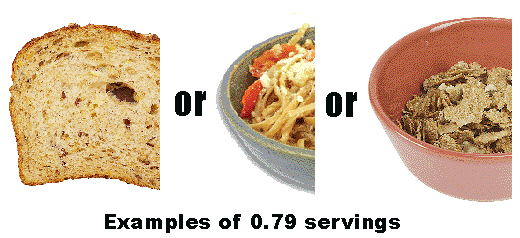Share This
The good news is: U.S. whole grain consumption rose 23.4% from 2008 to 2010. The bad news is: we’re nowhere near to making at least half our grains whole.
According to new data released this month by USDA, overall whole grain consumption in 2007-08 averaged 0.64 daily servings per person; in 2009-10 it had risen to 0.79 servings. At the same time, refined grain consumption held fairly steady — so we’d be just fine if only the slogan were “Make 12% of your grains whole.” Oops.
Don’t get me wrong; we’re happy about that 23% increase. But keep in mind that everyone age nine and up is supposed to be eating at least 3 servings of whole grain each day. Reaching that level would require eating almost four times more whole grains – not just a 23% increase.
Here are some examples to help you picture 0.79 servings, as USDA defines servings. That could be ⅘ of a small slice of whole grain bread … ⅖ of a cup of whole grain pasta … or ⅘ of a cup of cold ready-to-eat cereal, for instance.
Those of you who follow USDA consumption data (not a lot of us, I’ll admit…) may say, “Wait a minute – weren’t we already at something like 1 serving per person per day??” Yes and no. This new USDA data has been delayed a few years while the agriculture department revamped its food database to more accurately measure whole grain consumption (among other improvements). Rather than simply classify a food as “yes, whole grain” or “no, not whole grain,” the new system aims to account more accurately for foods that contain a mix of whole and refined grains.
So comparing the old data to the new is like comparing the proverbial apples and oranges. We haven’t slipped back – we simply have a better look now at how our previous whole grain consumption was even lower than we may have realized.
Let’s take a closer look at the data. That 23.4% increase to 0.79 servings was an overall average for all people, age 2 and up. Individual groups did better than that, both in servings and in rate of increase. So let’s pat the winners on the back, with our Grainy Awards.
| Our awards for most whole grain servings go to: | |
| Women, age 30-39 | 1.02 servings |
| Men, age 50-59 | 1.00 servings |
| Men, age 60-69 | 0.97 servings |
| Women, age 60-69 | 0.93 servings |
| Men age 40-49 | 0.93 servings |
| Most improved player awards go to: | |
| Women, age 30-39 | +92.5% increase in whole grains |
| Boys, age 2-5 | +58.0% |
| Men, age 30-39 | +46.8% |
| Girls, age 2-5 | +41.9% |
We’re encouraged by the “most improved players” awards. It’s probably no coincidence that pre-schoolers age 2-5 and grown-ups age 30-39 are improving together; it tells us that young families are eating more whole grains, and that’s a good thing. Perhaps this will help start a new generation off on the right foot, which is always easier than changing established habits.
There’s one more important award to dole out. Who’s getting closest to making half their grains – 50% or more – whole? When we tout the number of servings, the guys get an advantage, because in general (with their larger body size) they are eating more servings of everything, overall. When we tout rate of increase, we may be giving an advantage to those who eat so few whole grains that any increase looks huge. So let’s look one more time at that data.
| Awards for best ratio of whole to refined grains go to: | |
| Women, age 70+ | 18.5% of grains are whole grains |
| Women, age 60-69 | 18.2% |
| Women, age 30-39 | 16.9% |
| Men, age 70+ | 15.9% |
| Women, age 50-59 | 15.8% |
Sorry, guys, here’s where the other side of the equation comes into play. Some of you may be eating more whole grains, but you’re still eating a lot of refined grains, and so are the gals. Sadly, people age 6-29 of both genders are all still eating less than 10% of their grains as whole grains. Overall, for everyone age 2 and up, we’re averaging 12% of our grains as whole grains, a long way from the recommended 50% or more. Remember, the goal here is both to increase whole grain consumption and to decrease refined grain consumption, not just to nibble a bit of whole grain on top of what we’re already eating.
Enough wringing of hands. It’s important to see the half of the glass that’s full. Whole grain consumption is up, and up strongly. Plus, market factors indicate that growth in whole grains has continued to be strong since 2010, so even this long-awaited data is by now eclipsed by continuing momentum in whole grains.
How has your whole grain consumption, or that of your family, changed in the last few years? Add your comments below! (Cynthia)


Comments
Add a Comment